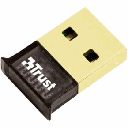Bluetooth
From ArmadeusWiki
Page under construction...
 Informations on this page are not guaranteed !!
Informations on this page are not guaranteed !!
This page will give you all the informations needed to have a running Bluetooth configuration on your Armadeus board.
Hardware
First you have to get a compatible hardware. Currently there are 3 solutions:
- Get a Wireless extension board from armadeus systems (only available for APF27)
- Get a cheap USB<->Bluetooth adapter (requires an USB Host port)
- Get a RS232<->Bluetooth adapter
Tested hardware
| Model | Status APF9328 / APF27 |
Chipset | Comments | |
|---|---|---|---|---|
BELKIN - Mini Bluetooth Adapter  |
TBT | KO | Product: BLUETOOTH USB +EDR ADAPTER v2.1 UHE Manufacturer: Broadcom Corp |
# hciconfig hci1 up piscan
btusb_submit_intr_urb: hci1 urb c3bdac40 submission failed (28) |
TRUST - Bluetooth 2.1 USB Adapter  |
TBT | KO | Product: BCM2046B1 Manufacturer: Broadcom |
# hciconfig hci1 up piscan
btusb_submit_intr_urb: hci1 urb c3bdac40 submission failed (28) |
RUEDUCOMMERCE - Mini adaptateur USB Bluetooth  |
TBT | OK | Manufacturer: Cambridge Silicon Radio | |
GIGABYTE - GN-BTD01  |
TBT | OK | Manufacturer: Cambridge Silicon Radio | Bluetooth 1.1 ? |
| BELKIN - F8T003 v2 | TBT | OK | Manufacturer: Cambridge Silicon Radio | |
Software
Bluetooth Linux stack is divided into several parts:
- kernel drivers
- userland libraries/daemon (bluez)
Driver installation
- (Done by default on APF27)
$ make linux26-menuconfig
[*] Networking support --->
<M> Bluetooth subsystem support --->
--- Bluetooth subsystem support
<M> L2CAP protocol support
<M> SCO links support
<M> RFCOMM protocol support
[*] RFCOMM TTY support
<M> BNEP protocol support
[ ] Multicast filter support (NEW)
[ ] Protocol filter support (NEW)
<M> HIDP protocol support
Bluetooth device drivers --->
<M> HCI USB driver
< > HCI SDIO driver (NEW)
<M> HCI UART driver
[*] UART (H4) protocol support
[*] BCSP protocol support
[ ] HCILL protocol support (NEW)
< > HCI BCM203x USB driver (NEW)
< > HCI BPA10x USB driver (NEW)
< > HCI BlueFRITZ! USB driver (NEW)
< > HCI VHCI (Virtual HCI device) driver (NEW)
$ make
Bluez installation
$ make menuconfig
Package Selection for the target --->
...
[*] XML handling --->
[*] libxml2
...
[*] Hardware handling / blockdevices and filesystem maintenance --->
[*] dbus
XML library to use (libxml2)
...
*** Armadeus specific packages ***
[*] bluez
$ make
Custom Bring up
APW
- APW has a CSR BlueCore 4 chipset connected to i.MX serial port ttySMX5 (UART6)
- Reset it:
# source /usr/bin/gpio_helpers.sh # gpio_mode PB14 1 # gpio_set_value PB14 0; sleep 1; gpio_set_value PB14 1; sleep 1
- Attach it to the kernel bluez UART driver:
# /usr/sbin/hciattach -s 921600 ttySMX5 csr 921600
USB module
- Make sure your hardware is connected to the APF. If using an USB dongle, load corresponding driver:
# modprobe btusb Bluetooth: Core ver 2.14 NET: Registered protocol family 31 Bluetooth: HCI device and connection manager initialized Bluetooth: HCI socket layer initialized Bluetooth: Generic Bluetooth USB driver ver 0.4 usbcore: registered new interface driver btusb
Common Bring up
- Check if Bluetooth interface was detected:
# hciconfig
hci0: Type: USB
BD Address: 00:00:00:00:00:00 ACL MTU: 0:0 SCO MTU: 0:0
DOWN
RX bytes:0 acl:0 sco:0 events:0 errors:0
TX bytes:0 acl:0 sco:0 commands:0 errors:0
- If interface is DOWN, bring it up:
# hciconfig hci0 up piscan
- Check your Bluetooth device is correctly initialized:
# hcitool dev
Devices:
hci0 00:10:60:D1:92:0F
Usage
Scanning network
- To get surrounding devices addresses and names:
# hcitool scan Scanning ...
- To get surrounding devices addresses and classes:
# hcitool inq Inquiring ...
Get info on a given device
# hcitool info 00:19:0E:xx:xx:xx ...
Pinging other devices
# l2ping 00:19:0E:xx:xx:xx Ping: 00:19:0E:xx:xx:xx from 00:19:88:xx:xx:xx (data size 44) ... 44 bytes from 00:19:0E:xx:xx:xx id 0 time 38.05ms 44 bytes from 00:19:0E:xx:xx:xx id 1 time 37.09ms ...
Here 00:19:0E:xx:xx:xx is the Bluetooth MAC address of the Host.
Setup a Terminal between a PC and your APF through Bluetooth
On the APF :
- the first step is to create the corresponding node for the future connection:
# mknod /dev/rfcomm0 c 216 0
- then, listen to an incoming connection, on the rfcomm0 (here channel 7 is choosen):
# rfcomm -i hci0 listen /dev/rfcomm0 7 &
- and the last step, when the connection is open, is to connect a terminal (through getty) to the device /dev/rfcomm0:
# getty 38400 /dev/rfcomm0
On the PC :
- after the two first steps on the APF, you need to connect the PC to the APF with the same channel (7):
$ rfcomm connect 0 00:19:88:2B:xx:xx 7 (replace 00:19:88:2B:xx:xx with the Bluetooth @ of your APF)
- and configure minicom ($HOME/.minirc.dfl):
pu port /dev/rfcomm0 pu baudrate 38400 pu bits 8 pu parity N pu stopbits 1
- when getty is running on the APF, you could you connect with minicom:
$ minicom -o
- it could be a good idea to create an additional user account for remotely login through Bluetooth, by following these instructions.